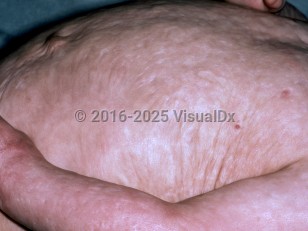A significant associated clinical feature of affected children is heat intolerance with an increased risk of hyperthermia. Scarred areas are hypohidrotic while uninvolved skin has compensatory hyperhidrosis. Some children also continue to have skin fragility in areas of scarring and in sites of trauma, which may lead to recurrent blisters and erosions; however, these lesions heal without scarring.
Associated findings are variable, with reported cases involving:
- Tongue – atrophy of lingual papillae; however, buccal mucosa and dentition are normal
- Scalp – sparse hair with resultant cicatricial alopecia, which may improve with time
- Nail – anonychia or hypoplasia of some or all nails
- Ocular – scarring of the cornea, fundus, or nasolacrimal duct
- Neurologic – cerebral palsy, hemiparesis, hearing loss, intellectual disability, mild developmental delays; it is unclear whether these are complications of prematurity or part of the cutaneous disease
- Other associated findings observed include erosive lichen planus, digital tip gangrene, aplasia cutis congenita, and hydronephrosis
- There may be a history of chorioamnionitis in the birthing parent



